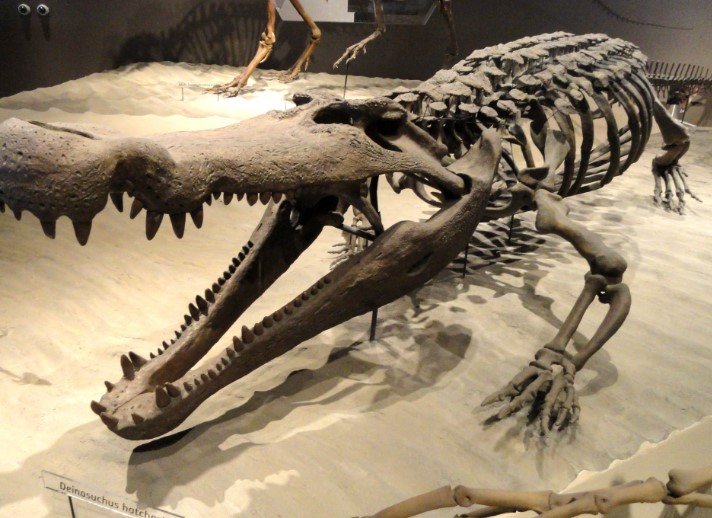Egyptian scientists have uncovered fossils of a new ancient crocodile species called Wadisuchus kassabi in the Western Desert, dating back 80 million years. This discovery, made in the Kharga Oasis, reveals key details about crocodile evolution and shows Africa as the origin point for seagoing crocs.
Discovery Details and Location
Paleontologists from Mansoura University found partial skulls and jaws of this four meter long predator in the Quseir Formation. The fossils come from the Campanian period, around 80 million years ago, during the Late Cretaceous era.
This find happened in the harsh sands of Egypt’s Western Desert, near red sandstones and green shales. Researchers used computer scans to study the bones without damage. The team named the species after the Arabic word for valley and a local geologist, honoring the region’s heritage.
Experts say this crocodile had a long snout and sharp teeth, perfect for catching fish in coastal waters. It lived before the mass extinction that ended the dinosaur age, offering clues on how some reptiles adapted to survive.

Impact on Crocodile Evolution
Wadisuchus kassabi stands as the earliest known member of the Dyrosauridae family. This group of crocs thrived in marine settings, unlike today’s freshwater types.
The discovery pushes back the timeline for dyrosaurid origins by millions of years. It suggests these animals first evolved in Africa, then spread to other continents after the asteroid impact 66 million years ago.
Scientists note that dyrosaurids filled empty niches in oceans post extinction. Their ability to live in salt water helped them outlast other reptiles. This find connects to recent studies on how climate shifts influenced animal adaptations during that time.
- Key traits of Dyrosauridae: Long narrow snouts for hunting slippery prey.
- Fine pointed teeth suited for fish and turtles.
- Bodies adapted for swimming in coastal and marine environments.
Scientific Analysis and Methods
The research team published their findings in a respected journal late last month. They examined two partial skulls and three jaw fragments using advanced imaging tools.
Fieldwork involved careful digging in the oasis to avoid breaking delicate bones. Lab work included comparing the fossils to known croc species from around the world.
This work builds on earlier discoveries in Egypt, like other Cretaceous reptiles found in the same desert. It highlights the Western Desert as a hot spot for paleontology, with layers rich in ancient life forms.
| Fossil Feature | Description | Significance |
|---|---|---|
| Snout Length | Elongated and narrow | Indicates marine hunting style |
| Tooth Structure | Needle like and pointed | Adapted for catching fast moving prey |
| Body Size | About 13 feet long | Shows it was a top predator in its ecosystem |
| Age | 80 million years old | Earliest dyrosaurid known |
Experts verified the age through rock dating methods, ensuring accuracy. The team plans more digs to find complete skeletons.
Broader Implications for Paleontology
This discovery reshapes views on reptile evolution after major extinctions. It shows how some species bounced back in changing environments.
In recent years, similar finds in Morocco and other African sites have added to this picture. For instance, a 2024 study on spinosaur fossils linked them to the same period, showing diverse predators in the region.
Wadisuchus kassabi also ties into ongoing debates about how crocs diversified. Modern crocs trace roots to these ancient lines, helping explain their survival today.
The find excites experts because it fills gaps in the fossil record. It could lead to new theories on migration patterns of early marine reptiles.
Connection to Modern Ecosystems
Understanding ancient crocs like this one helps explain current biodiversity. Today’s Nile crocodiles in Egypt share distant links to these ancestors.
Climate change studies benefit from this knowledge, as it shows how species adapted to warming seas in the past. Researchers see parallels to how animals might respond now.
Public interest in dinosaurs and ancient life spikes with such news. Museums in Egypt plan exhibits featuring this find to educate visitors.
Future Research and Expectations
Teams aim to explore more sites in the Western Desert for related fossils. They hope to uncover evidence of how these crocs interacted with other creatures.
International collaborations could speed up analysis, bringing in tech from global labs. Funding from universities supports these efforts, promising more breakthroughs soon.
This discovery reminds us of Egypt’s rich paleontological heritage, often overshadowed by its pharaonic history.
What do you think about this ancient crocodile find? Share your thoughts in the comments and pass this article along to fellow history buffs.
